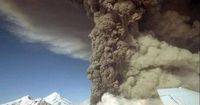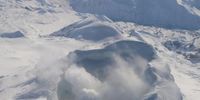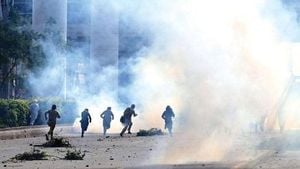In the wake of rising volcanic activity, residents in Southcentral Alaska are bracing for a potential eruption of Mount Spurr, located 78 miles northwest of Anchorage. Following a warning from scientists that an eruption is likely within the next few weeks to months, preparations have intensified among local inhabitants concerned about the impending ashfall that might blanket the region.
Mount Spurr, a stratovolcano standing at 11,000 feet, has a history of eruptions, having erupted four times in the past century—most notably in 1953 and three times in 1992. The latter events resulted in approximately a quarter-inch of ash accumulating across local communities, which caused significant disruptions, including the temporary shutdown of the Ted Stevens Anchorage International Airport for 20 hours, schools, and other services.
With the Alaska Volcano Observatory's (AVO) recent alert, Southcentral Alaska residents have been advised to prepare for ashfall that could range from one-eighth of an inch to a quarter-inch. The advisory includes essential recommendations on assembling disaster supply kits, which should consist of two weeks' worth of nonperishable food and water, flashlights, and cellphone chargers. Moreover, special supplies for volcanic eruptions—like N95 masks, vehicle air filters, and plastic sheeting—are encouraged to shield homes and properties.
Experts emphasize that ash poses a serious risk to public safety, primarily affecting transportation. Volcanic ash can critically impair visibility for pilots, damage engines and overall aircraft performance. According to the U.S. Geological Survey, airborne ash significantly threatens aviation, as demonstrated during the previous eruptions when flights were cancelled en masse.
“Ash can hurt not only aircraft but it also poses risks for ground transportation,” said Matt Haney, the scientist in charge at the AVO. “Driving conditions become hazardous due to reduced visibility, and roads can get slick with ash.” Residents are encouraged to avoid unnecessary travel should an ashfall occur, and to insure their vehicles against ash damage by washing them thoroughly afterward and ensuring the internal filters are changed.
Pet owners should also have contingency plans in place. With the ash known to irritate animal lungs and skin, veterinarians suggest keeping pets indoors and washing off any ash exposure immediately. Local retailers like AK Bark have noted a surge in demand for protective pet gear, including canine masks and goggles. Owner Mark Robokoff remarked, “We've seen an increase of about 800 sales of canine masks. People are being proactive about safeguarding their pets.”
Homes and infrastructure are not exempt from the impending threat of ash. Authorities from Chugach Electric Association stated that although they do not anticipate significant power outages due to ashfall, residents must take precautions to shield heating and air conditioning systems from potential clogging. Recommendations include using temporary filters for air intake systems to minimize dust ingress and monitoring ash accumulation around properties.
Local school districts—specifically, the Matanuska-Susitna Borough School District and the Anchorage School District—are also preparing for possible disruptions. They have issued tentative plans outlining how to manage potential school closures or early dismissals depending on the timing and severity of any eruption. “Our main goal is to keep students safe and informed throughout this process,” stated John Notestine, a spokesman for the Mat-Su Borough School District.
As the volcano shows no immediate signs of dramatic action yet, continuous monitoring remains crucial. Scientists plan to conduct additional aerial assessments to detect gas emissions and other critical data indicative of volcanic behavior.
On March 21, 2025, another flight over Mount Spurr was scheduled to measure gas levels and observe seismic activity. Notably, volcanic tremors, which often preclude an eruption, have not yet been detected. Haney indicated that the timeline for an eruption remains uncertain but pointed out that based on historical data, residents will likely have adequate warning to prepare.
“In past eruptions, we've observed that volcanic tremors typically emerge a few weeks to months ahead of any explosive activity. We haven’t observed that signal yet,” Haney noted.
With a spirit of preparedness on the rise, Southcentral Alaska residents are not taking any chances. Individuals shopping for supplies are recognizing the potential realities of a volcanic eruption, bolstering their readiness for whatever nature may throw their way. This spirit of vigilance is crucial, as the legacy of Mount Spurr emphasizes the necessity of remaining alert and informed in proximity to such a powerful natural force.







